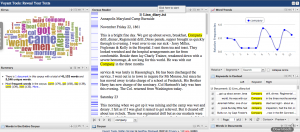Blog #2: “On Distant Reading”
Due: 9/24
In this blog post you are going to use the full compiled transcription of the Linn diary.
What is the value of distant reading? How can it help us to examine a text and illuminate aspects of that text that might not be so clear to us through traditional reading methods? They invite us to play with texts in a way we have not been able to before. Despite the temptation to dismiss this play as trivial, many critics see visualization as an interface in an iterative process of play; as part of the process of problem-generating. So what do you think? DOES distant reading (and in this case textual visualization) help us to examine a text in a meaningful way? When you look at a textual visualization – a Cirrus (or word cloud), a network of names, a graph that shows word frequencies – what questions do you start to ask about that text? What connections do you see? Remember that while the computer generates patterns, the computer cannot ask the questions. You must determine what those patterns mean.
After the battle at Roanoke Island, Linn makes this observation in his diary: “War is horrible. I first saw the pomp & circumstance – the battle field – the dead and wounded now the prison ship.” (Tuesday, February 18)
Jakacki hypothesis: I would propose that this short statement, coming roughly halfway through our text, demonstrates a profound shift in James’s perception and a loss of innocence.
Prompt: Can a distant reading of the text confirm or refute my hypothesis?
Example: I’m going to start by giving you an example: I ran the Linn Diary text file through Voyant: (http://voyant-tools.org/) as per the instructions I gave you last week. The word in the Cirrus that drew my eye was “company” (I don’t know why), and so I clicked on it and this is what the dashboard revealed to me: 
The word “company” appears 68 times in the text. Looking at the corpus reader, I see that there are places in the text where the word appears more frequently. Looking at the Word Trends panel, I see that there are two spikes in its usage: in segment 6 and 9. When I click on the Word Trends graph at points 6 and 9, I see that those spikes occur at February 6 and March 27. Perhaps equally important (or confusing), there is a sharp drop in the use of the word “company” just before March 27.
So can I apply the word “company” and come away with a definitive yes, or no to the research question? I don’t think so. I’m disappointed. I thought I would have an “ah ha” moment and be able to show that yes, the word patterns show me that my hypothesis is correct, that a word chosen at random will support my perspective on Linn’s development as a person.
But I’m determined. What happens if I add a second word to see if I can adjust that pattern?
I choose the word “wounded” (by typing it into the “search” bar below the Word Trends graph.) Now I see this:
Focusing on the Word Trends panel, I now see that there are some correlations between Linn’s use of the words company and wounded. The word wounded appears only 31 times in the text, and seems to follow along the same trajectory as the word company in the second half of the text. Does the combination of these words tell me definitively that Linn loses his innocence after the battle of Roanoke? I’m not sure. What it does is encourage me to ask a new question: why does Linn write these two words more frequently in the second half of the narrative? What is the correlation between company (his comrades, his most immediate fellow soldiers) and wounded (the violence that Linn saw happening to around him during the two battles)?
So for your post, I would like you to do the same thing. Follow the same process I did above, but choose your own word from the Cirrus. Once you’ve examined that word in the various panels, look for a second word that you think might correspond to (or contrast with) the first.
What do the words that you’ve chosen reveal about Linn’s experience in battle? Do they reveal anything at all? Remember that you may find that your words help you to support the hypothesis I have presented (in which case you should explain why you think they do) or that they help you to refute the hypothesis I have presented (in which case you should explain why you think my hypothesis is faulty.) You may also discover that my question ultimately serves only to lead you to one that you think is more important (in which case you should explain what that new research question is.) You may conclude that this form of textual analysis is helpful when asking these questions, or that it doesn’t help you to consider the questions that *you* want to ask about Linn and his diary.
Because this is different and we’re all experimenting with how to make sense of this, I encourage you to look at one another’s posts to see how they are approaching the question. If you’re interested, take a look at what Professor Faull’s students are thinking about in their blog posts for her section of HUMN 100. They may have considered some things about the relative benefit of distant reading that you might want to adapt for your own thinking.
Reminder: give your post the category “Blog #2.” Add two (2) screen images – similar to the ones I’ve shown above. Include five tags that you think reflect the work that you submit. Please review the Blog Assignment description and rubric and email me with any questions you may have.

